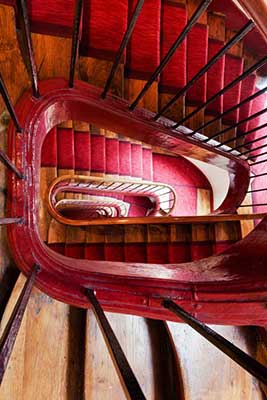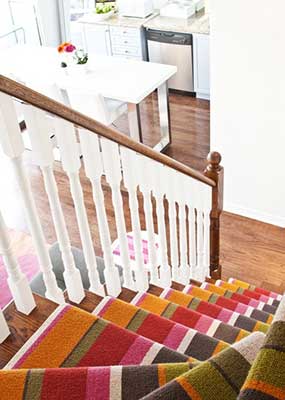Carpet runners look great on stairs, and there are some practical reasons for having them. Carpets will reduce noise and will reduce wear to the stair itself. They can also make the stairs less slippery and easier on the feet. You can install a carpet runner yourself—here’s how—however, we can connect you with professional carpet installers, as well.

Talk to an expert first
Talk to one of our Fowles experts about the type of carpet that is appropriate for a stair runner, including the carpet material and especially the underlayment pad. The pads add to the noise reduction, and will make the carpet last longer. Don’t use standard foam pads; they won’t provide the necessary support necessary.

Technical terms
The tread of the stair is where you put your feet. Rising vertically from the back of the tread is the riser. In most timber stairs, the tread protrudes at the front over the riser. This protrusion is called the nose. You’ll need a series of tackless strips. These are strips of wood, usually Douglas Fir, about 120 cm long and 2.5 cm wide, and they have very sharp nails protruding from them and small, sharp barbs embedded and angled at about 60 degrees.
Carpet tools required
You will need a tack hammer, framer square, rubber hammer, carpet tool or dull chisel and knee kicker. The latter tool is a long metal device that has a pad at one end. If you have to cut the carpet or if you are buying a remnant, you’ll also want a good supply of carpet glue.
The carpet runner should overlap the pad
Typical stairs are 76.2cm wide. The runner should be 66cm wide and the tackless strips should be cut to 62cm. Measure the width of the stair, subtract the width of the runner and divide by two. Measure this distance on the stair and mark it. Use a framer square to make sure the line is square. Attach the tackless strips to the back of the tread, ensuring they are centred and the barbs face the riser. Optionally, you can attach a second tackless strip about 7.5cm from the bottom of each riser with the barbs facing downward.
Cut the pad so that it runs from the edge of the tackless strip to the underside of the nose. Use a staple gun to attach the pad to the tread, butted against the tackless strip and under the nose. Use a framing square to determine if the runner is square. If it isn’t, cut the runner until it is and apply carpet glue to the cut edges to prevent fraying.
You can start from either the bottom or the top of the stairs. Unroll the runner and check that it is square. Line the runner up to the marks and position the knee kicker against the carpet at the point where the riser meets the tread. When you use your knee to put pressure on the knee kicker, the runner should engage the tackless strip. If there’s a bulge, lift the runner straight up and try again. Use the rubber mallet and carpet tool or chisel to pack the runner tightly against the riser. Staple the runner directly to the stair, not the padding. Repeat until you are finished.
If you have any questions, our expert carpet installers are available to assist you—or you could ask them to do the job.
